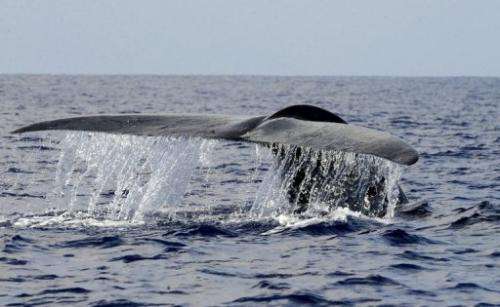High tech helps scientists protect whales

Scientists are delving deep into the travels of whales—thanks to high-tech tracking devices—to try to help protect them.
Except for a few species, global whale populations have been decimated over the last few hundred years. Many are at less than 10 percent of their original population size, following aggressive hunting in the 19th and early 20th centuries.
Today, whales are threatened by collisions with ships, getting trapped in fishing nets and from industrial acoustic disturbances caused by ship traffic, said Daniel Palacios at the Institute of Marine Sciences at the University of California Santa Cruz.
To better protect them, scientists at the annual American Association for the Advancement of Science conference in Boston said they need to better understand how and when whales eat and breed, and where they travel.
But that information has been difficult to obtain, Palacios said, because scientists have only recently gotten hold of technology to track whales for up to a year.
Other sea animals have been tracked for a long time.
"But tagging and tracking such large animals has been a huge problem over the last 25 years," said Palacios.
With the newly collected data "we have examined about 200 tracks from (four) different species in different oceans basins," he added.
Whales can swim between 620 and 3,100 miles (1,000 and 5,000 kilometers) per year depending on the species
"What we see is that is that whales engage in sort of local restricted movements, and then they would take off and follow very direct paths with a very high precision," Palacios said.
Zoologists have found that blue whales—the largest animal on earth, measuring up to 32 meters (105 feet) long and weighing up to 200 tonnes—feed for several months off the coast of Santa Barbara, California, in the middle of shipping lanes for vessels heading to the busy port of Los Angeles.
Climate change also threatens whales, said Nicholas Pyenson, curator at the Smithsonian's National Museum of Natural History in Washington.
"It's a very big problem because of the magnitude and rate the climate is changing," Pyenson said. "These animals are going everywhere."
Grey whales, for example, are breeding off the coast of Baja California, then swim to the Bering Sea.
"They have a very specific style of feeding on the sea floor off the coast of Alaska, so we don't really know what is going to happen with climate change, especially to these kinds of low-floor food resources," he said.
(c) 2013 AFP
















